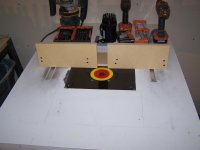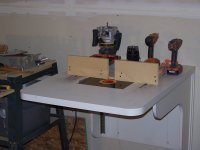Well, after a LONG time in the works I finally have finished my router table.
I am off to the hardware store to get longer screws to hold my router to the mounting plate.
I built the fence from 3/4" MDF & hardwood blocks for square.
I have another chunk of T-Track that I will sink in to the table so I can use a mitre gauge.
I am off to the hardware store to get longer screws to hold my router to the mounting plate.
I built the fence from 3/4" MDF & hardwood blocks for square.
I have another chunk of T-Track that I will sink in to the table so I can use a mitre gauge.
Attachments
Last edited:
Looks like a good example of a shop-built unit that has 90% of the functionality of a commercial unit, at 10% of the cost. Leaving plenty left over for router bits, safety glasses, hearing protectors, etc.
I can't tell from the photos - is that anchored to the wall and supported by the wall; or is it a free-standing unit?
Does being open below the table top cause sawdust problems? I like the openness underneath for easy access to the router but don't like the way it sprays sawdust around the workshop - so my versions of this design get moved to the deck or patio behind the house when I use them. The version I use indoors has a "skirt" of scrap 1/8" paneling extending about 18" below the table top to help confine the sawdust to the area immediately under the router table - but it's definitely a pain when I make adjustments to the machine.
Dale
I can't tell from the photos - is that anchored to the wall and supported by the wall; or is it a free-standing unit?
Does being open below the table top cause sawdust problems? I like the openness underneath for easy access to the router but don't like the way it sprays sawdust around the workshop - so my versions of this design get moved to the deck or patio behind the house when I use them. The version I use indoors has a "skirt" of scrap 1/8" paneling extending about 18" below the table top to help confine the sawdust to the area immediately under the router table - but it's definitely a pain when I make adjustments to the machine.
Dale
Einric,
Looks nice. A Feature that I find useful on the shaper I have is the ability to have the infeed fence a bit behind the outfeed fence. The outfeed is set exactly to the material after the cut, and the infeed being a bit back allowing the shaper to work as a jointer assuring a full cut. This is only used when running bits without bearings. Have fun...be careful.
Evan
Looks nice. A Feature that I find useful on the shaper I have is the ability to have the infeed fence a bit behind the outfeed fence. The outfeed is set exactly to the material after the cut, and the infeed being a bit back allowing the shaper to work as a jointer assuring a full cut. This is only used when running bits without bearings. Have fun...be careful.
Evan
I will be making an attachment point on the underside of the mounting plate for a 4" floor nozzle for my shop vac.
That way it will suck the dust straight out the gap on the router frame regardless of the bit size or the fence position.
The fence halves are not independent of each other since I only have 2 T-Tracks for the fence to slide in.
I may work out a slightly different design that could allow up to 1/8" offset on the outfeed since I would never "joint" a greater thickness than that in a single pass.
I do have a jointer but its from the 50's and it's wicked, one of them plug it in and take a step back things.
It's also nice that I can swing the arms underneath in and the table lays flat to the wall, it only sticks out 4" when collapsed.
That way it will suck the dust straight out the gap on the router frame regardless of the bit size or the fence position.
The fence halves are not independent of each other since I only have 2 T-Tracks for the fence to slide in.
I may work out a slightly different design that could allow up to 1/8" offset on the outfeed since I would never "joint" a greater thickness than that in a single pass.
I do have a jointer but its from the 50's and it's wicked, one of them plug it in and take a step back things.
It's also nice that I can swing the arms underneath in and the table lays flat to the wall, it only sticks out 4" when collapsed.
Practical thinking for a small shop.It's also nice that I can swing the arms underneath in and the table lays flat to the wall, it only sticks out 4" when collapsed . . . .
You may find some good ideas, and even completely documented designs, for this and other jigs or fixtures at "RouterForums.com" { http://www.routerforums.com/ } I've built the push block at { http://www.routerforums.com/jigs-fixtures/3543-deluxe-push-block-4.html } and use it with my homemade dovetail/box joint jig.. . . The fence halves are not independent of each other since I only have 2 T-Tracks for the fence to slide in.
I may work out a slightly different design that could allow up to 1/8" offset on the outfeed . . . .
Be careful what you say about things from the 50's. Some of us may take it personally.I do have a jointer but its from the 50's and it's wicked . . .
Dale
My buddy actually built the table for my father to spec.
My dad was going to use it as a collapsible computer workbench but it was WAY too heavy for him and my mom to pick up.
As soon as I saw it and my dad offered it to me I knew exactly what it was going to become.
I have at least a half dozen projects requiring mortise & tennon joinery that I finally can complete.
My dad was going to use it as a collapsible computer workbench but it was WAY too heavy for him and my mom to pick up.
As soon as I saw it and my dad offered it to me I knew exactly what it was going to become.
I have at least a half dozen projects requiring mortise & tennon joinery that I finally can complete.
As in......my jointer is a finger chopper offer'.
I need some kind of rubber feet for the stand because it dances around the room and just the pressure of you pushing your stock across it it will slide around because of all the vibrations.
Jointer should run smooth, even the little benchtops. Are you sure you don't have a bad belt, missing blade bolt, or something?
I like the way you have it up off the floor. Easy to sweep up.
- Status
- This old topic is closed. If you want to reopen this topic, contact a moderator using the "Report Post" button.
- Home
- Design & Build
- Equipment & Tools
- DIY Router Table

